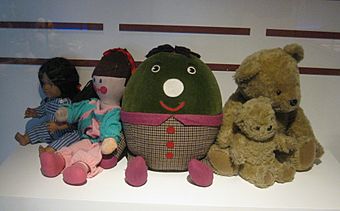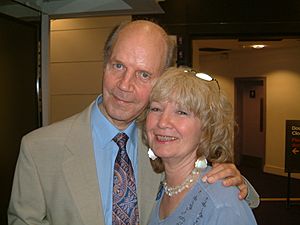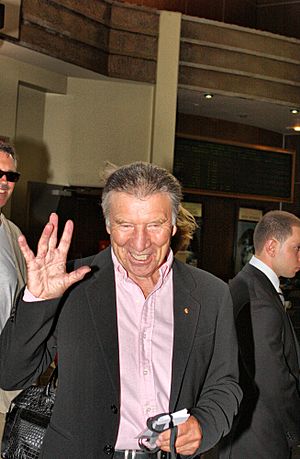Play School (British TV series) facts for kids
Quick facts for kids Play School (UK) |
|
|---|---|

The toys: Poppy, Jemima, Humpty, Little Ted, Big Ted, on display at the National Science and Media Museum
|
|
| Genre | Children's television series |
| Created by | Joy Whitby |
| Starring | Various presenters |
| Country of origin | United Kingdom |
| Original language(s) | English |
| Production | |
| Executive producer(s) | Cynthia Felgate (1972–1983) |
| Running time | 23 minutes |
| Release | |
| Original network | BBC2 also BBC1 from 1983 |
| Picture format | PAL |
| Audio format | Mono |
| Original release | 21 April 1964 – 11 March 1988 |
Play School was a popular British TV show for young children. It was made by the BBC and ran for a long time, from April 21, 1964, to March 11, 1988. Joy Whitby created the show. Each episode had a main idea and featured songs, stories, and fun activities with presenters. A short film was also shown, introduced through one of the famous windows on the set.
The show was so successful that many similar versions were made in Britain and other countries. Many different presenters and musicians worked on Play School over its 24 years. Even though it got a new look in 1983, the basic idea of the show stayed the same. It ended in 1988 and was replaced by a new show called Playbus, which later became Playdays.
Contents
What Happened on the Show?

A fun part of each episode was a short film about the outside world. Viewers were asked to guess which window the film would appear through: the round, square, or arched window. Later, a triangular window was added in 1983. These films often showed how things were made, like chocolate biscuits in a factory. They also showed everyday life, such as garbage collection, animals, or children playing.
At the start of the 1983 changes, the windows were called "shapes." Presenters would say, "Let's have a look through one of the shapes." Later, the show went back to using windows, similar to the ones from the 1970s, but with the new triangular window.
Every episode also had a story read from a book. Before the story, presenters would check the time on a special clock. They would ask viewers to guess the time, like "two o'clock." Then, they would reveal a clue under the clock, like toy animals, that hinted at the story. A catchy, clock-like tune played during this part.
The idea of the clock and choosing a window is still used in other children's shows today. For example, Tikkabilla uses similar ideas.
Most of the shows were made in a studio. But sometimes, they would film outside in different places. These included zoos, beaches, central London, churches, schools, and farms.
Each episode also featured songs, games, poems, and craft activities. Presenters often encouraged children at home to join in. They would usually say goodbye by saying, "Time for us to go now, but only until tomorrow." If it was the end of the week, they would say, "Goodbye, until it's our turn to be here again." This was because the presenters changed each week.
From 1971 to 1984, Play School had a related show called Play Away.
Play School Around the World

Play School became popular in many countries. Australia bought the show and then started making its own version in 1966. New Zealand also bought the show before making their own Play School from 1972 to 1982 and again from 1986 to 1989. Canada had its own version called Polka Dot Door, which ran from 1971 to 1993. The American children's show Zoom was also based on Play School.
Other countries, like Norway (Lekestue), Switzerland and Austria (Das Spielhaus), Italy (Giocagiò), Spain (La Casa Del Reloj), and Israel, received scripts and film clips to create their own versions of the show.
Presenters of Play School
The very first episode was presented by Virginia Stride and Gordon Rollings. Many other people presented the show during its 24-year run.
- Rick Jones
- Carole Ward
- Brian Cant
- Eric Thompson and his wife Phyllida Law
- Julie Stevens
- Terence Frisby (as Terence Holland)
- Marla Landi
- Paul Danquah
- Gordon Clyde
- Valerie Pitts
- Colin Jeavons
- Carol Chell
- Miranda Connell
- Wally Whyton
- Ann Morrish
- John White
- Johnny Ball
- Lionel Morton
- Chloe Ashcroft and her husband David Hargreaves
- Diane Dorgan
- Johnny Silvo
- Derek Griffiths
- Beryl Roques
- Sarah Long
- Toni Arthur
- Carmen Munroe
- Don Spencer
- Jon Glover
- Fred Harris
- John Golder
- Karen Platt
- Carol Leader
- Stuart McGugan
- Chris Tranchell
- Floella Benjamin
- Ben Bazell
- Sheelagh Gilbey
- Elizabeth Millbank
- Ben Thomas
- Christopher Bramwell
- Lucie Skeaping
- Iain Lauchlan
- Patrick Abernethy
- Elizabeth Watts (presenter)
- Brian Jameson
- Wayne Jackman
- Jane Hardy
- Stuart Bradley
- Kate Copstick
- Delia Morgan
Only four presenters worked on the show in all three decades it was on air: Brian Cant (1964–85), Carol Chell (1966–88), Johnny Ball (1967–84 & 1986–87), and Chloe Ashcroft (1969–88). Carol Chell was the presenter who stayed the longest and appeared the most times, with 763 episodes. Other presenters who were on the show for 10 or more years included Julie Stevens, Derek Griffiths, Fred Harris, Don Spencer, Sarah Long, Floella Benjamin, Stuart McGugan, and Carol Leader.
Famous Storytellers
Many famous people also appeared on Play School to read stories. Some became regular guests. These included: Val Doonican, Richard Baker, Rolf Harris, Clive Dunn, Roy Castle, Pat Coombs, David Kossoff, Patricia Hayes, Sam Kydd, James Blades, Frank Windsor, Roy Kinnear, George Chisholm, Ted Moult, and Cilla Black. Even past and present Play School presenters often came back to read stories.
Musicians on the Show
Many talented musicians worked on Play School over the years. Some of them were Jonathan Cohen, William Blezard, Peter Gosling, Alan Grahame, Paul Reade, Spike Heatley, Alan Rushton, Pedro Goble, Anne Dudley, John Gould, Martin Yates, and Peter Pettinger. Some musicians, like Jonathan Cohen and Peter Gosling, even appeared on camera sometimes, especially during Christmas episodes.
The Play School Toys
The presenters were always joined by a group of friendly cuddly toys and dolls. The five main toy friends were:
- Humpty: A large, dark green, egg-shaped soft toy with green trousers. He looked like Humpty Dumpty from the nursery rhyme. Humpty was in the very first show in April 1964. Several versions of Humpty were made over the years.
- Big Ted and Little Ted: These were teddy bears. At first, there was only one teddy bear. But it was stolen in the mid-1970s, so it was replaced by two new teddy bears, Big Ted and Little Ted.
- Jemima: A rag doll with long red (or pink) and white striped legs.
- Hamble: A small doll and one of the original five toys. She was removed from the show in the 1980s. The creator of Play School, Joy Whitby, chose Hamble to represent a more "humble" background. Presenters found her hard to cuddle because she wouldn't sit up. One presenter, Chloe Ashcroft, once put a knitting needle inside Hamble to make her sit straight!
- Poppy: A black doll who replaced Hamble in November 1986. This change happened as society's views changed, and the Hamble doll was also getting very old and fragile.
A rocking horse named Dapple also appeared sometimes, usually when a song or story fit with a horse. The final group of toys from the show are now on display at the National Science and Media Museum in Bradford. However, the Hamble doll went missing after she was no longer on the programme.
The Play School Pets
The show also featured several real pets! They were cared for by Wendy Duggan, who was a Fellow of the Zoological Society.
- Katoo, Charlie, and Sparky – cockatoos
- Bit and Bot – goldfish
- Rabbits, including Buffy, Mopsy, Peter, Benjamin, and Becky
- Mice
- Guinea pigs, including Lizzy
Images for kids
-
Don Spencer, who appeared on the original British version and also on the Australian adaptation


